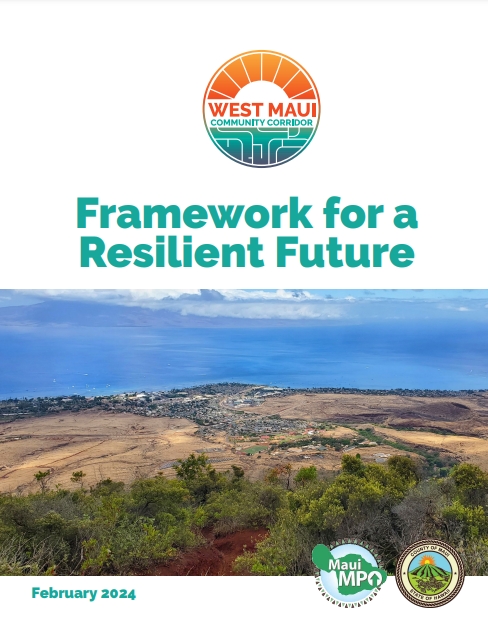
On August 8, 2023, West Maui and Lahaina Town changed forever. Devastating fires tore through the community, claiming at least 101 lives. Homes and businesses were destroyed, including important cultural, historical, and spiritual sites. In a matter of hours, everything changed for this busy, thriving community and the people who call it home.
To support West Maui’s recovery efforts, the West Maui Community Corridor project changed course. Rather than an action plan, as originally intended, the project team developed a “Framework for a Resilient Future.” The framework is an expression of the vision and hopes we heard from the West Maui community, supported by technical analysis and the learnings of the project team. It offers focus areas and near-term projects to consider, all of which must be confirmed with the community.
The framework captures the hard work of West Maui residents, the Maui Metropolitan Planning Organization (MPO), and Maui County while recognizing that the landscape and the community’s needs have changed since the fires. We hope the West Maui Community Corridor “Framework for a Resilient Future” can be a resource for planning and designing West Maui’s next steps. The community has an opportunity to reflect upon and express what matters in new ways, honoring West Maui’s past, current, and future kama‘āina and the lands that are their kuleana.
A Path Forward
Please review the “Framework for a Resilient Future” to learn more about the Community Corridor project’s outcomes.
What is the West Maui Community Corridor and why was the project needed?
By 2040, nearly 33,000 more people will call Maui home. While growth can present new opportunities, it’s not without challenges. Maui is facing an affordable and workforce housing crisis, and our transportation system doesn’t provide options for everyone. These issues are even more pressing due to the devastating fires.
The West Maui Community Corridor project was intended to address economic diversity, resiliency, housing availability and affordability, and multimodal transportation. From ways to support local businesses and provide opportunities for economic development to thinking creatively about how we connect people to jobs, services, and schools, the Community Corridor tackled questions about high-quality public bus service; safe places to walk, bike, and roll; new housing types; and businesses and services that better support West Maui residents.
Although the project changed in response to the August 2023 fires, the “Framework for a Resilient Future” offers ideas for learning from the past to envision a new future for the 3.6 miles of Honoapiʻilani Highway that connect Lahaina to Kā‘anapali.
What is a transit-oriented community?
It’s a place that makes it easy to take the bus and to walk, bike, and roll. It’s also a place that has many different types of affordable and workforce housing options. A community corridor provides many opportunities for connecting schools, services, jobs, and great community spaces that are welcoming and fun.
Where was the project's study area?
The West Maui Community Corridor was focused on the area from Lahaina to Kā‘anapali along Honoapi‘ilani Highway, from the shoreline to roughly a half mile mauka. It included the neighborhoods along Lahainaluna Road that connected Lahaina's schools to its center. Beyond the corridor itself, the project explored connections near the corridor including neighborhoods, businesses, parks, and community facilities, such as schools, medical facilities, and churches.

How did this project relate to past work in West Maui
The West Maui Community Corridor built on previous plans and policies. Our team reviewed and learned from the documents linked below, and you’re welcome to check them out as well.
-
West Maui Community Plan (2022)
-
Vision Zero Maui Action Plan (2021)
-
State of Hawaii Strategic Plan for Transit-Oriented Development (2018)
-
Maui Island Plan (2012)
-
Countywide Policy Plan (2010)
Project History
This project was made possible by a grant from the State Legislature. The Hawaiʻi Interagency Council for Transit-Oriented Development (TOD Council) was instrumental in helping us start this work. The State of Hawaii Strategic Plan for Transit-Oriented Development was created by the TOD Council to set a vision for using State facilities to spark public and private investments in compact, walkable communities.
The West Maui Community Corridor was Maui’s second TOD corridor project. It followed the Ka‘ahumanu Ave Community Corridor, which sets a vision for a transit-oriented community in the heart of Central Maui.

